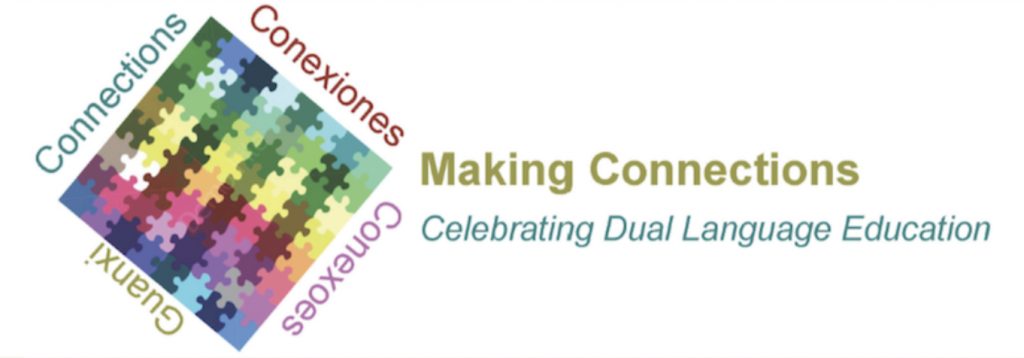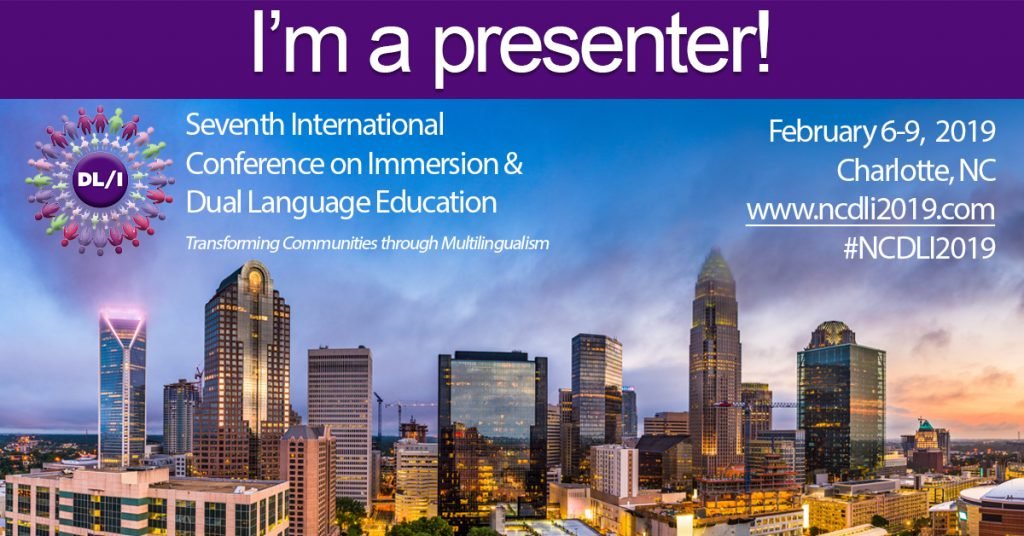Southern New England Regional Dual Language Conference

Saturday, March 23, 2019 MABE’s eighth annual Southern New England Regional Dual Language Conference. Nathanael Greene Elementary School 285 Smithfield AvePawtucket, RI 02860 School visits: March 18-22 Theme: Making Connections:Focus on Culture For registration and more information visit: www.mabene.org
Seventh International Conference on Immersion & Dual Language

February 6-9, 2019, Charlotte, NC I will be presenting at the Seventh International Conference on Immersion & Dual Language. For more information please visit conference website.
Happy Thanksgiving – Feliz día de acción de gracias

This Thanksgiving, we would like to thank all of our TaJu Educational Solutions friends, extended family and partners around the world. Happy Thanksgiving! Be well my friends!
Honored to Present: “Hidden Blind Spots” @ the 2018 METCO Association
“Hidden Blind Spots: Systematically Confronting the Inequities Faced by Linguistically and Culturally Diverse Populations”, presented by Alexandra Guilamo – Friday, December 7, 2018 It is such an honor to be able to present this interactive workshop designed to give educational leaders the tools to systematically confront issues of access and equity faced by linguistically and culturally diverse studentsby: exploring our own identities and attitudes about linguistically and culturally diverse populations; constructing a model that defines the extent to which blind spots (or entrenched perceptions) are (1) created by experiences, (2) utilized to shape our judgments and beliefs, and (3) applied unconsciously as we make decisions that limit access and opportunity; drawing conclusions about the impact of our blind spots on range of educational decisions such as program models, language policies, instructional practices, curricular materials, providing opportunities for intervention and acceleration, and more; developing tools to advocate and respond to inequities faced by linguistically and culturally diverse populations; developing action steps for systematically recognizing and confronting blind spots to ensure all learners have access to an educational experience that unlocks their full potential.
Come Visit Me @ La Cosecha: November 15th
If you are considering a dual language program or are early in your adoption, please stop by my session which I will be presenting on Thursday, November 15th at 3:00 pm (Inn & Spa at Loretto, Acoma North). The title of my session is The Dual Language Start Up Kit: 10 Essentials for Years 1-3, which provides essential guidance that all districts need to ensure a sustainable program that allows students to realize the three pillars of dual language education.
What does your Dual Language MTSS process look like?
The multi-tiered system of support is a critical framework to ensure ALL Dual Language students are successful. However, when designing MTSS for Dual Language Programs, we must do so with a number of assumptions related to implementation. As with any educational program, all Dual Language programs need a focus on a strong core, or tier one – one that has: clear standards for the content, clear standards for literacy (or language arts) that is unique to each program language, clear standards for language development for each program language, clear processes for differentiating and scaffolding instruction so that ALL dual language students have access to grade level rigor. As part of this tier one planning, universal assessments and systems to analyze those assessments will be essential in helping us consider the interaction between language, literacy, and cultural reference points in order to ensure each student’s success. As with all tier 1 models, three times a year, all Dual language students are assessed to determine and analyze the linguistic growth, literacy development, and academic achievement of all students in a way that is authentic to each language & systematic across and within the dual language program. This combination of data for both program languages is used to (a) identify students making adequate progress using wholistic biliteracy trajectories normed against dual language learners, (b) identify students who are not fully making adequate progress and require extra assistance, or (c) identify students who have a critical need for specialized supports. A brief model of how all three tiers operate together is shared below.
Thank you teachers! ¡Gracias maestros!
Thank you for serving our schools and communities to provide high quality learning every day and allowing TaJu to be a partner in that journey. From everyone at TaJu Educational Solutions, thank you, teachers! You are the change we seek in the world.
Top 5 Ways to Spend Down F18 Budget & Grow Your Dual Language and Bilingual Programs:
In the next few weeks, schools and districts across the country are in the midst of a crazy time between now and June 30th called “spend down”, it is the last few months of the year where they are forced to either spend their remaining budgets, or risk losing that money altogether. For many schools, this means ordering supplies, technology, and other catalog “wish list” items that were not possible during other times of the year. However, there is very little evidence that using funds for these “wish list” items has any impact on student achievement. One reason might be that educators have very little time to learn how to best utilize these purchases to support the needs of their students. Most likely, these additions rarely lead to improvement in practice and outcomes for students because the pressure to spend now before the time is up also prevents thoughtful planning for how these additions fit into current systems and structures. So how do you avoid the shopping spree mentality and invest your final F18 budget in a way that makes a difference for your language learners? As schools also begin planning their professional learning for the 2018-2019 school year, the five areas below are several “must have’s” that all schools should include and advocate for their dual language and bilingual programs. Program evaluation: Every dual language and bilingual program must analyze the needs of their educational community before building a comprehensive plan to coordinate supports. Careful diagnosis of the districts’ programs must include an analysis of a variety of data sources, as well as utilizing other qualitative data to ensure effective services and outcomes. The process should be methodical and flexible for dual language and bilingual program administrators to get a clear understanding of accountability, evidence to support a new program implementation, increase effectiveness of pedagogy and practices, or generally assessing needs. Leadership Training: Every leader should have the training and tools to lead and grow their dual language and bilingual programs. This includes understanding how the curriculum and instructional practices should look the same and when they should look different in these classrooms. Additionally, every DL and bilingual program leader (building and district level) should have the opportunity to build their capacity for observing instruction that occurs in a language other than English and offering constructive feedback around strengths and opportunities for growth. This cycle of feedback is a critical lever for improving student achievement. Equity Training: As record achievement gaps are reported across the country for dual language, bilingual, and English Learners, schools must work together to explore and analyze issues of inequitable distribution of resources, limited access in education, and how issues of race, culture, language, and identity create doors or barriers to opportunities for students. If schools are to change limiting beliefs, policies, and resource distribution models, misconceptions about students assets (rather than their deficits), social norms, and academic achievement must be rooted in a deeper understanding of the role that bias (both blatant and invisible) plays in the academic success of each student. Accepting the sociocultural-linguistic biases within their schools improves educators’ ability to become mutually responsible learners with and from students to design more effective practices, materials, and systems that lead to student growth. Spanish Literacy: Teachers have many opportunities to build their expertise and knowledge of strategies to teach reading in English. However, very few teachers in dual language and bilingual programs have received ongoing professional development that support their examination of the similarities and differences between English and Spanish. In addition to speaking Spanish, teachers in dual language and bilingual programs need to explicitly learn how Spanish literacy is developed authentically if they are to create a literacy experience that develops the sounds, words, sentence structures, and context that help students become biliterate. Ongoing coaching plans for key personnel: Educators need continuous follow up during the implementation of new ideas and practices – initial training is simply not sufficient. Ongoing coaching plans for key personnel (e.g. instructional coaches, dual language teachers, principals, etc.), allow schools to design coaching cycles which can encompass the following components: building the initial prerequisite skills & understandings, expertise in practices & tools to make new learning accessible, fidelity of implementation, effectiveness through formative assessment, and differentiated support based on need to continue improving practice. If you are interested in more information regarding any of these school supports, we would appreciate the opportunity to discuss supporting you through your program’s dual language, bilingual, ELL, and leadership training needs to improve your diverse students’ long-term success. Please email us at alexandra.guilamo@tajulearning.com or call us at 312 – 800 – 3477.
FREE workshop cohosted by TaJu Educational Solutions & West 40 Regional Service Center of Illinois
Are your teachers who serve language learners drowning in data but don’t know what to do with it all? Join Alexandra Guilamo next Thursday, April 12, 2018, for a FREE workshop hosted by TaJu & West 40 Regional Service Center of Illinois, to discover how easy it can be to use language and literacy data in a meaningful way! Learn how to use language & literacy data, and performance definitions during as part of the planning process Get ideas on how to use language acquisition theory to increase academic achievement. Experience scaffolding strategies that reach all language learners. Create a plan that focuses on differentiation that makes a difference Register Today! https://raisingachievement.eventbrite.com
Want a More Culturally Just Curriculum: Start with the Self
The first step in ensuring a socio-culturally just educational experience was to recognize the hidden bias of our assumptions by looking inward. As educators, what are our experiences, our appearance that informs how we move through different communities, our norms, and our privileges? Once we acknowledge these aspects of ourselves, we can then look to learn about our culturally and linguistically diverse students. Who are they and what are their experiences that define their beliefs and how they see the world beyond just a data point?
